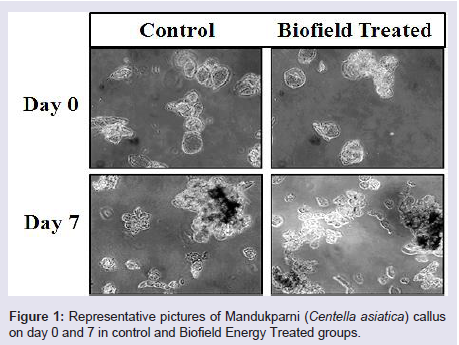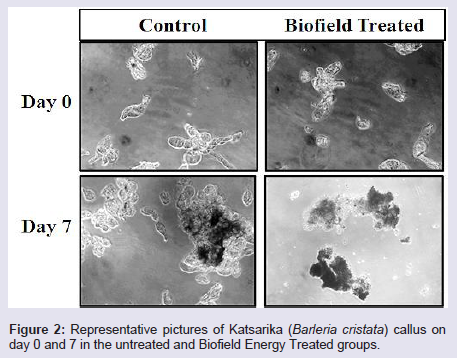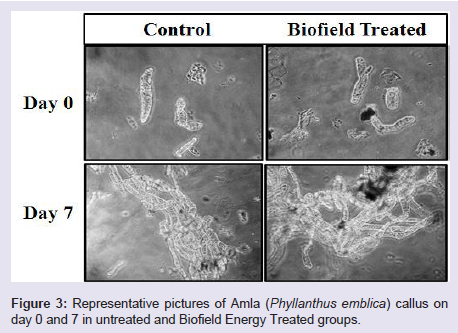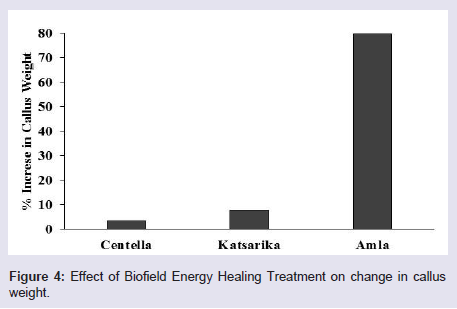Journal of Plant Biology & Soil Health
Download PDF
Research Article
Impact of the Trivedi Effect ®- Energy of Consciousness Healing on Growth and Yield of the Plant Stem Cells Culture
Alice Branton1, Mahendra Kumar Trivedi1, Dahryn Trivedi1, Gopal Nayak1 and Snehasis Jana2*
- 1Trivedi Global Inc., Henderson, USA
- 2Trivedi Science Research Laboratory Pvt. Ltd, India
*Address for Correspondence: Snehasis Jana, Trivedi Science Research Laboratory Pvt Ltd, Hall-A, Chinar Mega Mall, Chinar Fortune City, Bhopal-462026, Madhya Pradesh, India, Tel: +91-755-6660006; E-mail: publication@trivedisrl.com
Citation: Branton A, Trivedi MK, Trivedi D, Nayak G, et al. Impact of the Trivedi Effect®-Energy of Consciousness Healing on Growth and Yield of the Plant Stem Cells Culture. J Plant Biol Soil Health. 2018;5(1): 5.
Copyright: © 2018 Branton A, et al. This is an open access article distributed under the Creative Commons Attribution License, which permits unrestricted use, distribution, and reproduction in any medium, provided the original work is properly cited.
Journal of Plant Biology & Soil Health | ISSN: 2331-8996 | Volume: 5, Issue: 1
Submission: 03 September, 2018 | Accepted: 29 September, 2018 | Published: 03 October, 2018
Abstract
The objective of the present study was to evaluate the effect of Biofield Energy Healing Treatment on the plant callus of Mandukparni (Centella asiatica), Katsarika (Barleria cristata), and Amla (Phyllanthus emblica) in Murashige & Skoog liquid medium (MS) for their yield on day 7. All the three plant callus and MS liquid media were divided into two parts, one part was received Biofield Energy Treatment (known as The Trivedi Effect®-Energy Of Consciousness Healing Treatment) by a renowned Biofield Energy Healer, Alice Branton through the Healer’s unique Energy Transmission process remotely and defined as Biofield Energy Treated group. Another part did not receive any treatment and defined as the control group. On day 7 after the treatment, the flasks were observed and visualized under the phase contrast microscope for monitoring the cell growth and photomicrographs were captured at 200X magnification along with the wet weight of the callus cultures. Experimental data suggested that all the three plants viz. Mandukparni, Katsarika, and Amla callus showed significantly improved growth rate after seven days as compared with the respective untreated groups. The growth of the callus (weight in mg) of Mandukparni, Katsarika and Amla callus after 7 days of the Biofield Energy Treatment was 289.7, 348.5, and 512 mg respectively. However, the percentage increase in weight of the callus in Mandukparni, Katsarika, and Amla was 3.3%, 7.7%, and 79.6%, respectively as compared with the untreated group. Hence, the results indicated that there was a significant growth observed after The Trivedi Effect®-Energy of Consciousness Treatment in the tested plant stem cells. It can be concluded that The Trivedi Effect® would be used as a complementary and alternative treatment to maximize most valuable natural products yield and quality best quality such as herbal medicinal plants, food and dietary supplements, flavoring and coloring agents, cosmetics and fragrance products, and many more.
Keywords
Energy of consciousness healing; The Trivedi Effect®; Yield improvement; Plant tissue culture; Centella asiatica; Barleria cristata; Phyllanthus emblica
Abbreviations
MS: Murashige and Skoog (1962) medium; NAA: α-naphthaleneacetic acid; IAA: Indole-3-acetic acid; 2,4-D: 2,4-dichlorophenoxyacetic acid; BAP: 6-benzylaminopurine; KIN: Kinetin; NPs: Natural products
Introduction
Plants are the best source of a wide variety of chemical molecules with many biological activities. Data suggested that more than 200,000 high-value natural products (NPs) have been recognized, which have been utilized as drugs such as codeine, morphine, and paclitaxel [1]. Other NPs are used as food flavouring and colouring agents such as anthocyanins, saffron, and spearmint. For the management of pest and disease management, some NPs are commonly used such as nicotine, strychnine, and azadirachtin, while lavender, rosemary, and aloe vera are used for the cosmetics and fragrance products [2]. Most commonly, these NPs are produced commercially by extracting various plant sources along with other approved methods. However, important medicinal plants have not been domesticated in large scale, which leads to limiting the wild-populations and potential of producing active molecules. Synthesis of NPs using chemical process is another alternative strategy, which can circumvent some aspects of semi-synthetic issues, however, it remains the costly approach that can produce toxic by-products in NPs [3]. In addition, another wellestablished technology platform for NPs synthesis is the plant cell culture with several advantages. Plant callus culture is the successful method from experimental to the commercial platform for the synthesis of high-value phytoconstituents [4]. Although callus culture and regeneration of various plants have already been recognized using different methods [5], the present study assessed the growth and yield of selected plant callus of Mandukparni (Centella asiatica), Katsarika (Barleria cristata) and Amla (Phyllanthus emblica) after treatment with The Trivedi Effect®-Energy of Consciousness Healing Treatment by a renowned Biofield Energy Healer, Alice Branton.
Centella asiatica L. generally defined as Indian pennywort from family Apiaceae. Multiplication of its callus has been studied through shoot tip culture and meristem tip culture [6,7]. As a complementary medicine, it is used clinically for asthma, nervine tonic, skin diseases, dropsy, hypertension, bronchitis, and urethritis [8]. Phyllanthus emblica Linn. known as Indian gooseberry or amla of family Euphorbiaceae, commonly used as medicine and as a tonic to boost the vitality and vigor. It has been traditionally used as anti-inflammatory, antianemia, cardioprotective, antipyretic, antidiarrheal, analgesic, wound healing, and many more [9]. Similarly, Barleria cristata, a perennial shrub from family Acanthaceae has been reported to have many biologically active compounds such as iridoids, flavonoids, and phenylethanoid derivatives [10].
Over the past few decades, many researchers have been interested in the potential mechanisms of certain energy-healing practices in different biological fields. As a result, healing practitioners (The Trivedi Effect®) have been involved in a wide number of preclinical, In vitro cell lines, analytical, pharmaceutical, agricultural studies. Biofield Energy Healing as a Complementary and Alternative Medicine (CAM) that proofed significant results in biological studies [11]. However, the National Center for Complementary and Alternative Medicine (NCCAM), well-defined Biofield therapies in the subcategory of Energy Therapies. Hence, Biofield Energy Healing is increasingly accepted to promote human wellness as an alternative approach [12,13]. The Trivedi Effect®-Consciousness Energy Healing Treatment has been reported with significant revolution in the physicochemical properties of metals, chemicals, ceramics and polymers [14-17], improved agricultural crop yield, productivity, and quality [18-20], transformed antimicrobial characteristics of pathogenic microbes at genetic level [21-23], improved biological activity of nutraceutical compounds for skin health [24,25], livestock [26], and many more.
Materials and Methods
Chemicals and reagents
Liquid MS medium (Murashige Skoog’s) was purchased from Sigma-Aldrich. Serological pipettes and T75 culture flask were procured from Thermo Scientific, while culture petridish and 200 μL microtips were purchased from Tarson, US. All the other chemicals used in this experiment were analytical grade procured from local vendors.
Experimental design
The experimental groups were consisted of three group’s viz. plant callus of mandukparni, katsarika, and amla callus. Each callus culture and plant MS media were divided into two parts, control and Biofield Energy Treated. All the groups were visualized for growth and yield of the callus on day 0 and day 7.
Energy of consciousness treatment strategies
The plant callus (mandukparni, katsarika, and amla) containing flasks and MS media were divided into two parts. One part of each samples (plant callus and MS media) was treated with the Biofield Energy (The Trivedi Effect®) and coded as the Biofield Energy Treated test samples, while the second part of the test samples did not receive any sort of treatment and was defined as the untreated test samples. This Biofield Energy Healing Treatment was provided by a renowned Biofield Energy Healer, Alice Branton who participated in this study and performed the Biofield Energy Treatment remotely for ~5 minutes. Biofield Energy Healer was remotely located in the USA, while the test samples were located in the research laboratory of Dabur Research Foundation near New Delhi, India. This Biofield Energy Treatment was administered for 5 minutes through the Healer’s unique Energy Transmission process remotely to the test samples under laboratory conditions. The Biofield Energy Healing Treatment was performed without any contact with the plant callus and MS media samples. Biofield Energy Healer in this study did not visit the laboratory nor had any contact with the samples. Further, the control group was treated with a sham healer for comparative purposes. The sham healer did not have any knowledge about the Biofield Energy Treatment. After that, the Biofield Energy Treated and untreated samples were kept in similar sealed conditions for experimental study.
Plant collection and surface sterilization
Healthy leaflet of mandukparni, katsarika, and amla explants were collected inappropriately sized. All the explants were thoroughly washed with running tap water for 20 min in order to remove the traces of dust, etc. followed by washing with fungicide solution. Further, the explants were surface sterilized using 70% ethanol for about 40 seconds and again washed with 4-5 times with sterile double distilled water.
Culture media and conditions
Fine cuts were made in the young leaf (wound induction) and were cultured on Murashige Skoog’s (MS) basal medium, gelled with 0.8% agar containing 3% sucrose. The pH of the callus medium was adjusted approximately 5.8 before agar was gelled. All the plant callus cultures were maintained in growth conditions at 25 ± 2° C and 60% to 70% relative humidity with a photoperiod of 16 hours at 3000 lux light intensity with a photoperiod of 16 hours light and 8 hours dark.
Plant callus suspension culture
The cultures were incubated in a culture room and after some days, callus induction was started in all the samples. Further, the suspension culture was made from the friable creamish calli and was transferred to the T75 culture flasks in liquid MS media supplemented with different phytohormones like cytokines (6-Benzylaminopurine, BAP with 5.0 mg/L and kinetin, KIN with 0.5 mg/L concentration) and auxins (α-naphthaleneacetic acid, NAA with 2.0 mg/L and 2,4-dichlorophenoxyacetic acid, 2,4-D with 2.0 mg/L). Aliquots of Mandukparni (Centella asiatica), Katsarika (Barleria cristata) and Amla (Phyllanthus emblica) stem cells were cultured in T-75 cell culture flasks. The flasks received Biofield Energy Treatment (known as The Trivedi Effect®) at this stage without touching the cells. Following the treatment, the above T-75 flasks were incubated till day 7 in a shaking incubator (120 rpm) under the photoperiod of 16 hours at 3000 lux light intensity provided by cool white fluorescent tubes. The incubation conditions were similar to that of untreated cells. On day 7, the flasks were observed and visualized under phase contrast microscope for monitoring cell growth and photomicrographs were captured at 200X magnification. The wet weight of all the callus was taken after day 7 [27].
Statistical analysis
All the data were expressed as percentage of the each sample, and were subjected to one-sample t-test for comparison. Statistical significance was considered at p≤0.05.
Results and Discussion
Effect of biofield energy healing treatment on mandukparni (Centella asiatica) callus growth and yield
The results of the growth and yield of plant callus of Mandukparni (Centella asiatica) after Biofield Energy Healing Treatment by Alice Branton are presented in Figure 1. Centella asiatica callus flasks were observed and visualized under phase contrast microscope for cell growth and photomicrographs were captured at 200X magnification on day 0 and day 7. The plant callus at day 7 as presented showed significant growth after Biofield Energy Treatment, while the callus growth was high on day 7 as compared with the untreated plant callus and MS media. However, experimental data suggested that the Mandukparni weight of callus in the untreated group was 280.6 mg, while it was 289.7 mg in the Biofield Energy Treated group. Overall, the data showed 3.3% increase in plant callus growth as compared with the control group. Biofield Energy Treatment showed improved callus growth, which can be used to isolate more NPs against many biological disorders. Centella asiatica contains asiaticosides, which are reported in the treatment of leprosy and tuberculosis [28]. In addition, various biological activities such as antileprotic, antibacterial, antioxidant, antifeedant, and antituberculosis properties of Centella asiatica was due to its glycosides such as indocentelloside, brahmoside, brahminoside, asiaticoside, and theankuniside [29]. This is assumed that The Trivedi Effect® has significant capacity to improve the callus growth of Centella asiatica, which suggest its application against various pharmacological activities.
Figure 1: Representative pictures of Mandukparni (Centella asiatica) calluson day 0 and 7 in control and Biofield Energy Treated groups.
Effect of biofield energy healing treatment on katsarika (Barleria cristata) callus growth and yield
Katsarika (Barleria cristata plant callus growth and yield after Biofield Energy Healing Treatment by a renowned Biofield Energy Healer, Alice Branton is presented in Figure 2. Katsarika callus flasks were observed and visualized under phase contrast microscope for cell growth and photomicrographs were captured at 200X magnification on day 0 and day 7. The plant callus at day 7 as presented showed a significant growth after Biofield Energy Treatment, while the callus growth was high on day 7 as compared with the untreated plant callus and MS media. However, experimental data suggested that the katsarika weight of callus in the untreated group was 323.7 mg, while it was 348.5 mg in the Biofield Energy Treated group. Overall, the data showed 7.7% increased in plant callus growth as compared with the control group. The results assumed that Biofield Energy Healing Treatment has significant capacity to improve the phytoconstituents of Barleria cristata, such as iridoids, flavonoids, and phenylethanoid derivatives, which can be used against skin diseases, bronchitis, blood diseases, and asthma [10].
Figure 2: Representative pictures of Katsarika (Barleria cristata) callus onday 0 and 7 in the untreated and Biofield Energy Treated groups.
Effect of biofield energy healing treatment on amla (Phyllanthus emblica) callus growth and yield
Amla (Phyllanthus emblica) plant callus growth and yield after Biofield Energy Healing Treatment by a renowned Biofield Energy Healer, Alice Branton is presented in Figure 3. Amla callus flasks were observed and visualized under phase contrast microscope for cell growth and photomicrographs were captured at 200X magnification on day 0 and day 7. The plant callus at day 7 showed significant improved growth after Biofield Energy Treatment, while the callus growth was significantly high on day 7 as compared with the untreated plant callus. However, experimental data suggested that the weight of amla callus in the untreated group was 285 mg, while it was 512 mg in the Biofield Energy Treated group. Overall, the data showed 79.6% increased in the growth of amla plant callus as compared with the untreated control. Phyllanthus emblica is an important dietary source of vitamin C, amino acids, and minerals due to the presence of phytoconstituents such as emblicol, phyllembelic acid, phyllembelin, rutin, curcuminoids, phenolic compounds and tannins. The improved growth of the plant callus after the Biofield Energy Treatment can be used to isolate the important phytoconstituents of amla, which can be used as antidiarrheal, analgesic, wound healing, antitussive, antiatherogenic, antiatherosclerotic, adaptogenic, gastroprotective, antihypercholesterolemia, hepatoprotective, nephroprotective, and neuroprotective properties [30].
Figure 3: Representative pictures of Amla (Phyllanthus emblica) callus on day 0 and 7 in untreated and Biofield Energy Treated groups.
Overall, The Trivedi Effect®-Energy of Consciousness Healing Treatment on plant callus of Mandukparni (Centella asiatica), Katsarika (Barleria cristata) and Amla (Phyllanthus emblica) showed a significant improvement of the weight of Phyllanthus emblica callus followed by Barleria cristata and Centella asiatica callus (Figure 4).
Biofield Energy Healing Treatment as a complementary and alternative medicine approach can be used to induce significant high callus growth, which would be an important scale-up strategy for the production of most valuable natural products. This Energy Healing Treatment can also be used to overcome the limitations of plant stem cell callus culture and its yield. Secondary, it might be possible that Biofield Energy Healing Treatment (The Trivedi Effect®) would improve the plant callus yield of Mandukparni (Centella asiatica), Katsarika (Barleria cristata) and Amla (Phyllanthus emblica) stem cells by optimizing the limiting factors of the callus culture like nutrient availability, low-shear environment, adequate mixing, and reducing mass transfer for improved oxygen. These natural products from plant callus after Biofield Energy Treatment would be the alternative approach that have long plethora of applications in case of different medicines, fragrances, dyes, and flavors due to increased interest in the natural products for many regulatory agencies.
Conclusions
Biofield Energy Healing Treatment has been proven to induce very high growth rate and yield of Mandukparni, Katsarika, and Amla stem cells. The experimental results showed significant plants callus growth and their weights. The Trivedi Effect®-Energy of Consciousness Healing Treatment showed 3.3% increased the Mandukparni callus (Centella asiatica), as compared to the untreated group. The Biofield Energy Treated Katsarika (Barleria cristata) callus weight was increased by 7.7%, as compared with the untreated group. In addition, the weight of Phyllanthus emblica callus of the control group was 285 mg, while it was found to be 512 mg in the Biofield Energy Treated group. It means that the percentage increase of Phyllanthus emblica callus weight was increased by 79.6% compared with the untreated group. Overall, these data suggest that Biofield Energy Healing Treatment by a renowned Biofield Energy Healer, Alice Branton has unprecedent capacity to increase the plant stem cells growth, which could be used to produce very high quality and yield of the most valuable natural products from different medicinal plants, which can be used as anti-inflammatory, immunostimulant, adaptogenic, hepatoprotective, and anticancer effects. Besides, The Trivedi Effect® can also be very useful for several industrial applications such as pharmaceuticals, nutraceuticals, cosmeceuticals, dyes, fragrances and food industries.
References
- Newman DJ, Cragg GM (2012) Natural products as sources of new drugs over the 30 years from 1981 to 2010. J Nat Prod 75: 311-335.
- Wu S, Chappell J (2008) Metabolic engineering of natural products in plants; tools of the trade and challenges for the future. Curr Opin Biotechnol 19: 145-152.
- Howat S, Park B, Oh IS, Jin YW, Lee EK, et al. (2014) Paclitaxel: biosynthesis, production and future prospects. N Biotechnol 31: 242-245.
- Fischer R, Vasilev N, Twyman RM, Schillberg S (2015) High-value products from plants: the challenges of process optimization. Curr Opin Biotechnol 32: 156-162.
- AbouZid S (2014) Yield improvement strategies for the production of secondary metabolites in plant tissue culture: silymarin from silybum marianum tissue culture. Nat Prod Res 28: 2102-2110.
- Nath S, Alak KB (2003) In vitro method for propagation of Centella asiatica (L) Ur Lucas ban by shoot tip culture. J Plant Biochem Biotechnol 12: 167-169.
- Tiwari KN, Sharma NC, Tiwari V, Singh BD (2000) Micropropagation of Centella asiatica (L.), a valuable medicinal herb. Plant Cell Tiss Org 63: 179-185.
- Kakkar KK (1998) Mandukaparni-medicinal uses and therapeutic efficacy. Indian Drug 26: 92-97.
- Krishnaveni M, Mirunalini S (2010) Therapeutic potential of Phyllanthus emblica (amla): The ayurvedic wonder. J Basic Clin Physiol Pharmacol 21: 93-105.
- El-Mawla AA, Ahmed AS, Ibraheim ZZ, Ernst L (2005) Phenylethanoid glycoside from Barleria cristata L. callus cultures. Bull Pharm Sci Assiut Univ 28: 199-204.
- Movaffaghia Z, Farsi M (2009) Biofield therapies: Biophysical basis and biological regulations. Complement Ther Clin Pract 15: 35-37.
- Peck SD (1998) The efficacy of therapeutic touch for improving functional ability in elders with degenerative arthritis. Nurs Sci Q 11: 123-132.
- Giasson M, Bouchard L (1998) Effect of therapeutic touch on the well-being of persons with terminal cancer. J Holist Nurs 16: 383-398.
- Trivedi MK, Tallapragada RM (2008) A transcendental to changing metal powder characteristics. Met Powder Rep 63: 22-28, 31.
- Trivedi MK, Nayak G, Patil S, Tallapragada RM, Latiyal O, et al. (2015) Studies of the atomic and crystalline characteristics of ceramic oxide nano powders after bio field treatment. Ind Eng Manage 4: 161.
- Trivedi MK, Nayak G, Patil S, Tallapragada RM, Latiyal O et al. (2015) Effect of biofield energy treatment on physical and structural properties of calcium carbide and praseodymium oxide. Int J Material Sci Applications 4: 390-395.
- Trivedi MK, Tallapragada RM, Branton A, Trivedi D, Nayak G, et al. (2015) Characterization of physical, thermal and structural properties of chromium (VI) oxide powder: impact of biofield treatment. J Civil Environ Eng 5: 196.
- Trivedi MK, Branton A, Trivedi D, Nayak G, Mondal SC, et al. (2015) Evaluation of plant growth, yield and yield attributes of biofield energy treated mustard (Brassica juncea) and chick pea (Cicer arietinum) seeds. Agriculture, Forestry and Fisheries 4: 291-295.
- Nayak G, Altekar N (2015) Effect of biofield treatment on plant growth and adaptation. J Environ Health Sci 1: 1-9.
- rivedi MK, Branton A, Trivedi D, Nayak G, Mondal SC, et al. (2015) Evaluation of biochemical marker-Glutathione and DNA fingerprinting of biofield energy treated Oryza sativa. Am J BioScience 3: 243-248.
- Trivedi MK, Patil S, Shettigar H, Gangwar M, Jana S (2015) Antimicrobial sensitivity pattern of Pseudomonas fluorescens after biofield treatment. J Infect Dis Ther 3: 222.
- Trivedi MK, Patil S, Shettigar H, Bairwa K, Jana S, et al (2015) Phenotypic and biotypic characterization of Klebsiella oxytoca: an impact of biofield treatment. J Microb Biochem Technol 7: 203-206.
- Trivedi MK, Patil S, Shettigar H, Gangwar M, Jana S, et al. (2015) An effect of biofield treatment on multidrug-resistant Burkholderia cepacia: a multihost pathogen. J Trop Dis 3: 167.
- Kinney JP, Trivedi MK, Branton A, Trivedi D, Nayak G et al. (2017) Overall skin health potential of the biofield energy healing based herbomineral formulation using various skin parameters. Am J Life Sci 5: 65-74.
- Singh J, Trivedi MK, Branton A, Trivedi D, Nayak G, et al. (2017) Consciousness energy healing treatment based herbomineral formulation: A safe and effective approach for skin health. Am J Pharmacol Phytother 2: 1-10.
- Trivedi MK, Branton A, Trivedi D, Nayak G, Mondal SC, et al. (2015) Effect of biofield treated energized water on the growth and health status in chicken (Gallus gallus domesticus). Poult Fish Wildl Sci 3: 140.
- Lucchesini M, Mensuali-Sodi A (2010) Plant tissue culture--an opportunity for the production of nutraceuticals. Adv Exp Med Biol 698: 185-202.
- Tiwari KN, Sharma NC, Tiwari V, Singh BD (2000) Micropropagation of Centella asiatica (L.), a valuable medicinal herb. Plant Cell Tiss Org 63: 179-185.
- Srisxvastava R, Shukla YN, Kumar S (1997) Chemistry and Pharmacology of Centella asiatica: A review. J Med Aromatic Plant Sci 19: 1049-1056.
- Baliga MS, Dsouza JJ (2011) Amla (Emblica officinalis Gaertn), a wonder berry in the treatment and prevention of cancer. Eur J Cancer Prev 20: 225-239.





